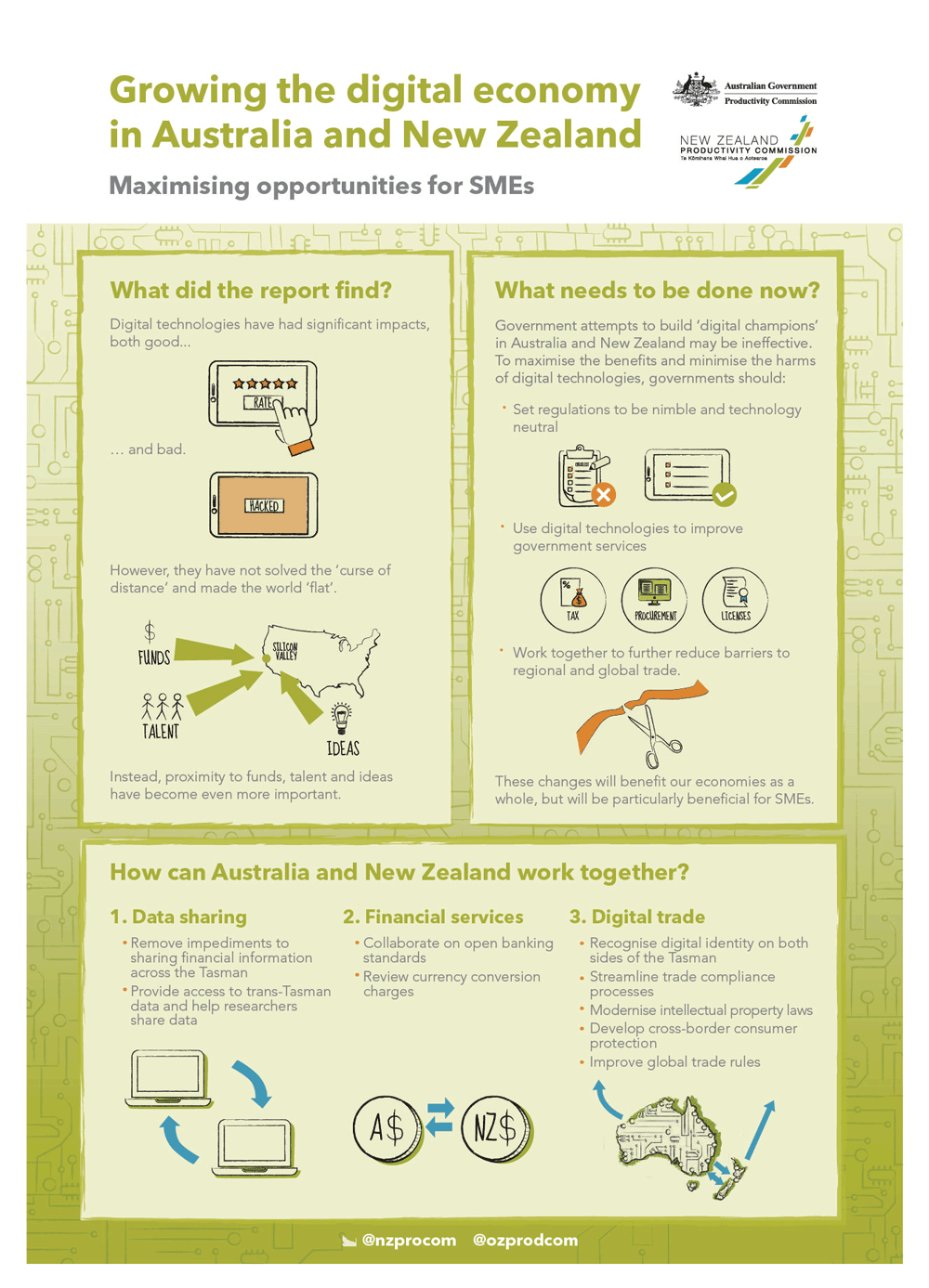Growing the digital economy in Australia and New Zealand: Maximising opportunities for small medium enterprises (SMEs)
Joint research report
This joint Australian and New Zealand report looks at the broad challenges and opportunities created by the digital economy and at what institutional and regulatory settings by the Australian and New Zealand Governments would be most effective. It identifies new opportunities for trans-Tasman collaboration in the delivery of trans-Tasman financial services, digital identity frameworks, streamlined digital trade processes and other areas.
The report was released on 14 February 2019.
Download the report
- Growing the Digital Economy in Australia and New Zealand: Maximising Opportunities for SMEs (PDF - 2316 Kb)
- Growing the Digital Economy in Australia and New Zealand: Maximising Opportunities for SMEs (Word - 1075 Kb)
- Infographic
- Contents
Download the infographic

Growing the Digital Economy in Australia and New Zealand: Maximising opportunities for SMEs (Text version of infographic)
What did the report find?
Digital technologies have had significant impacts, both good … (such as online rating systems) ... and bad (such as systems being hacked).
However, they have not solved the 'curse of distance' and made the world 'flat'.
Instead, proximity to funds, talent and ideas (such as those concentrated in Silicon Valley) have become even more important.
What needs to be done now?
Government attempts to build 'digital champions' in Australia and New Zealand may be ineffective. To maximise the benefits and minimise the harms of digital technologies, governments should:
- Set regulations to be nimble and technology neutral
- Use digital technologies to improve government services — including tax, procurement and licensing
- Work together to further reduce barriers to regional and global trade.
The changes will benefit our economies as a whole, but will be particularly beneficial for SMEs.
How can Australia and New Zealand work together?
- Data sharing
- Remove impediments to sharing financial information across the Tasman
- Provide access to trans Tasman data and help researchers share data.
- Financial services
- Collaborate on open banking standards
- Review currency conversion charges.
- Digital trade
- Recognise digital identity on both sides of the Tasman
- Streamline trade compliance processes
- Modernise intellectual property laws
- Develop cross-border consumer protection
- Improve global trade rules.
Twitter handles — @nzprocom @ozprodcom
- Preliminaries: Cover, Copyright and publication detail, Joint study terms of reference, Foreword and Glossary
- Executive Summary
- Chapter 1 Australia and New Zealand in the digital economy
- 1.1 Why digital matters
- 1.2 If digital is everywhere, where is its productivity impact?
- 1.3 Implications for Australia and New Zealand
- 1.4 Implications for governments
- 1.5 Where this report fits in
- Chapter 2 Regulation in the digital economy
- 2.1 Why governments regulate
- 2.2 How do digital technologies affect regulation?
- 2.3 How does regulation challenge digital firms and services?
- 2.4 How do Australia and New Zealand’s regulatory frameworks stack up?
- 2.5 Designing regulatory policy for the digital era
- Chapter 3 Government services in the digital economy
- 3.1 How are governments improving their interactions with firms?
- 3.2 How can digital improve government–firm interactions?
- 3.3 From ICT to digital-first, user-centred design
- 3.4 Creating value from public datasets
- 3.5 Looking forward
- Chapter 4 The trans-Tasman relationship and the digital economy
- 4.1 Developing policy for a digital trans-Tasman economy
- 4.2 Where to next?
- 4.3 A strong relationship will support the digital economy
- Appendix A Consultation
- Appendix B Data: SMEs, digital technologies, and trans-Tasman trade
- B.1 The digital economy in Australia and New Zealand
- B.2 Australia and New Zealand in the global digital economy
- B.3 Firms in Australia and New Zealand
- B.4 International trade
- References
Printed copies
Printed copies of this report can be purchased from Canprint Communications.
Publications feedback
We value your comments about this publication and encourage you to provide feedback.